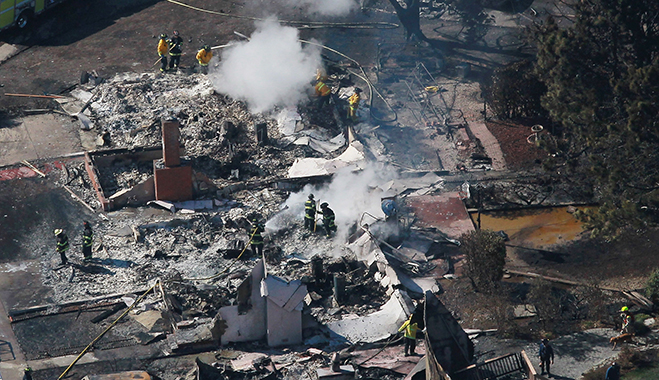
Four years after a natural gas explosion left a residential neighbourhood in California in ruins, killing eight people and seriously injuring dozens of others, the Pacific Gas & Electric Company has been hit with a $1.4bn penalty for suspected safety violations.
It is the largest safety penalty proposed by local regulator, the California Public Utilities Commission. But according to two administrative law judges, PG&E committed 3,798 violations of state and federal laws, rules, standards and regulations in connection with its pipeline.
The pipeline exploded in the San Bruno area in September 2010. The blast was so powerful that it dug a 22m-long crater and sent a 1.3-ton section of pipe flying across the neighbourhood. The ensuing blaze destroyed about 50 houses and lead to a mass evacuation of the area, while authorities and PG&E fought to contain the blast. It took more than 95 minutes for the utility company to isolate the break and shut off the gas, raising concerns about the care and maintenance of underground pipelines.
The settlement resolves claims by BP that Halliburton was to blame for the spill
So far, the firm has spent hundreds of millions of dollars settling claims by the victims and their families and contributing to recovery efforts in San Bruno.
“We are accountable and fully accept that a penalty of some kind is appropriate,” the company said in a statement. “However, we have respectfully asked that the commission ensure that the penalty is reasonable and proportionate and takes into consideration the company’s investments and actions to promote safety.”
Deepwater Horizon settlement
In related news, US federal authorities have secured $1.1bn from energy company Halliburton, which is looking to settle lawsuits stemming from the worst oil spill in US history. The settlement resolves most of the legal claims that Halliburton is facing over its role in the 2010 oil spill in the Gulf of Mexico.
Halliburton, which poured the cement on the well that was at the centre of the spill, is one of three companies blamed for the accident. BP, which owned the Macando well, has paid billions to businesses and individuals harmed by the spill, while Transocean, which operated the rig that was pumping oil out of the well, has also paid out big bucks.
The Deepwater Horizon oil rig exploded on April 20, 2010, killing 11 people and sending millions of gallons of oil into the Gulf. The well wasn’t successfully capped until three months after the explosion, causing extensive environmental damage.
The settlement resolves claims by BP that Halliburton was to blame for the spill.
So far, BP has agreed to pay $4.5bn in government penalties and has set up a $20bn trust fund to provide compensation for those harmed in the disaster. Similarly, Halliburton said it will pay the $1.1bn into a trust fund in three instalments over the next two years.
Following the Macondo accident, US offshore drilling safety regulation has been tightened significantly, setting unprecedented demands for rig safety and maintenance. Now that fracking and gas use is booming, broad-reaching probes into on-shore energy activities have followed.


